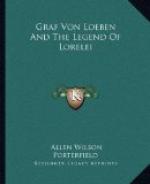The story[21] entitled Leda is again typical of Loeben. Briefly stated, the plot is as follows: Leda, the daughter of a Roman duke, loves Cephalo, who is a gentleman but not a nobleman, and is loved by him. Her father, however, has forced her to become engaged to Alberto, a man of high degree, whom she does not love. The wedding is imminent, and Leda is sorely perplexed. Her father does not know why she is so indifferent to the approaching event and accordingly sends her to a distant and lonely castle in the hope that she may become interested, at least, in her own nuptials. While there she drowns herself in the swan lake. Alberto drops out of the story, and Cephalo becomes the intimate friend of the duke. Previous to this Alberto had ordered a certain painter to paint a picture of “Leda and the Swan.” Danae, the daughter of an old, unscrupulous antiquarian, was seen by Cephalo while posing as a model for Leda. Enraged at this, she tells her father that she will not be appeased until married to Cephalo. But she loses her life through the falling of an old, dilapidated castle wherein she has been keeping an unconventional tryst, and Cephalo becomes the intimate friend of the painter.
Loeben’s ideas and technique stand out in every line of this story. One woman is placed between two men, unexpected friendships are developed, the lute and the zither are played in the moonlight, love and longing abound, nature is made a confidant, der Zaubern der Kunst is overdone, familiar stories—Leda and the Swan, Actaeon and Danae—are interwoven, there are manifest reminiscences of Emilia Galotti and Ofterdingen, and the prose is uncommonly fluent. The only character in the entire narrative who has any virility is the antiquarian, and he is one of the meanest Loeben ever drew. Alberto has no will at all, Leda not much, Cephalo less than Leda, and Danae is without character. In short, the only valuable, part of the story lies in its approach to a development of the psychology of love in art. But it is only an approach; and it does not make one feel inclined to read a vast deal more of the prose works of Graf von Loeben.
As to Loeben’s lyrics,[22] they are irregular, inconsistent, and odd as to orthography,[23] melodious and flowing in form, poor in ideas, rich in feeling that frequently sounds forced, representative of nearly all the important Germanic, Romance, and Oriental verse and strophe forms, reminiscent of his reading[24] in many instances, and romantic as a whole, especially in their constant portrayal of longing. Loeben was the poet of Sehnsucht. He tried always das Nahe zu entfernen und das Ferne sich nahe zu bringen. With a few conspicuous exceptions, his lyrics resemble those of Geibel somewhat in form and treatment. Poetry and individual poets receive grateful consideration, the seasons are overworked, love rarely fails and nature never, wine and the Rhine are not forgotten, and the South is poetized as the




